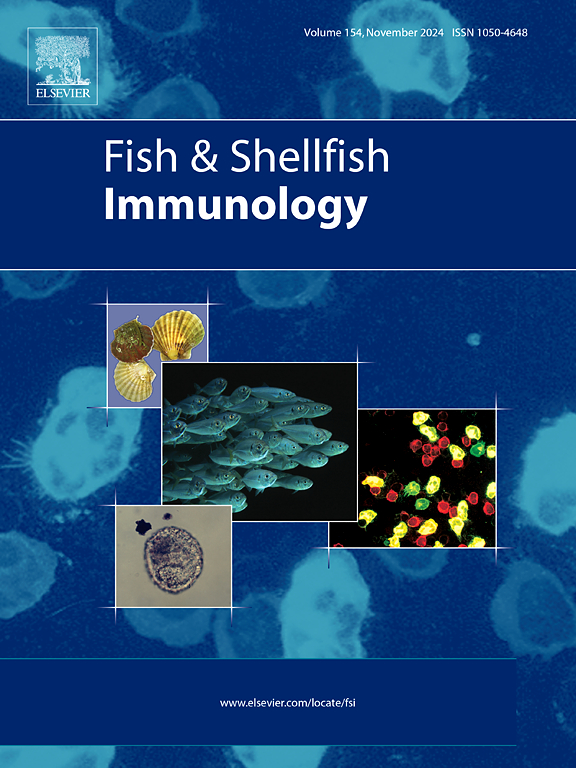Beclin-1 enhances autophagy and inhibits apoptosis to facilitate virus infection in Penaeus vannamei
IF 3.9
2区 农林科学
Q1 FISHERIES
引用次数: 0
Abstract
Beclin-1 is a crucial autophagy regulator that also affects innate immunity, including apoptosis. At the present day, nothing is known about Beclin-1 in crustaceans, especially Penaeid shrimp. This work examined the function of Beclin-1 from the Pacific white shrimp, Penaeus vannamei (PvBECN1), under both normal and white spot syndrome virus (WSSV) challenge circumstances. The phylogenetic tree analysis placed PvBECN1 in the same group as other Beclin-1 from penaeid shrimp. PvBECN1 was composed of BH3 domain, coiled-coil domain, and autophagy-specific (BARA) domain. PvBECN1 transcription was highest in the intestine and gill. Following WSSV infection, PvBECN1 expression increased in gills and hemocytes, though further investigation specifically focused on the hemocytes as a key immunological tissue. PvBECN1 silencing was conducted to obtain insight into the function of PvBECN1 during the virus infection. We discovered that suppressing PvBECN1 increaesd the survival rate of WSSV-infected shrimp by reducing the viral load. In term of immunity, PvBECN1 silencing, in both normal and WSSV infected conditions, led to a decrease in the percentage of autophagic activity. Concurrently, there was a significant increase in late apoptotic hemocyte cells and caspase 3/7 activity, demonstrating the involvement of PvBECN1 in innate immunity. Furthermore, following PvBECN1 knockdown, there was an altered expression of immune-related genes, including antimicrobial peptides and interferon-like genes. Interestingly, during WSSV infection, PvBECN1-silenced shrimp only exhibit overexpression of crustin and vago5. Ultimately, the virus enhances its replication and evades antiviral defense via triggering the PvBECN1 transcript.
Beclin-1增强南美对虾自噬和抑制细胞凋亡促进病毒感染
Beclin-1是一种重要的自噬调节因子,也影响先天免疫,包括细胞凋亡。目前,人们对贝克林-1在甲壳类动物中的作用一无所知,尤其是对虾。本研究检测了来自凡纳美对虾(Penaeus vannamei, PvBECN1)的Beclin-1在正常和白斑综合征病毒(WSSV)侵染环境下的功能。系统发育树分析表明,PvBECN1与来自对虾的其他Beclin-1属同一类群。PvBECN1由BH3结构域、coil -coil结构域和自噬特异性结构域(BARA)组成。PvBECN1转录在肠和鳃中最高。在WSSV感染后,PvBECN1在鳃和血细胞中的表达增加,尽管进一步的研究专门关注血细胞作为关键的免疫组织。PvBECN1沉默是为了深入了解PvBECN1在病毒感染过程中的功能。我们发现抑制PvBECN1通过降低病毒载量提高了感染wssv的对虾的存活率。在免疫方面,PvBECN1沉默,在正常和WSSV感染条件下,导致自噬活性百分比下降。同时,晚期凋亡血细胞和caspase 3/7活性显著增加,表明PvBECN1参与先天免疫。此外,PvBECN1敲低后,免疫相关基因的表达发生改变,包括抗菌肽和干扰素样基因。有趣的是,在WSSV感染期间,pvbecn1沉默的虾只表现出壳蛋白和vago5的过表达。最终,该病毒通过触发PvBECN1转录物来增强其复制并逃避抗病毒防御。
本文章由计算机程序翻译,如有差异,请以英文原文为准。
求助全文
约1分钟内获得全文
求助全文
来源期刊

Fish & shellfish immunology
农林科学-海洋与淡水生物学
CiteScore
7.50
自引率
19.10%
发文量
750
审稿时长
68 days
期刊介绍:
Fish and Shellfish Immunology rapidly publishes high-quality, peer-refereed contributions in the expanding fields of fish and shellfish immunology. It presents studies on the basic mechanisms of both the specific and non-specific defense systems, the cells, tissues, and humoral factors involved, their dependence on environmental and intrinsic factors, response to pathogens, response to vaccination, and applied studies on the development of specific vaccines for use in the aquaculture industry.
 求助内容:
求助内容: 应助结果提醒方式:
应助结果提醒方式:


